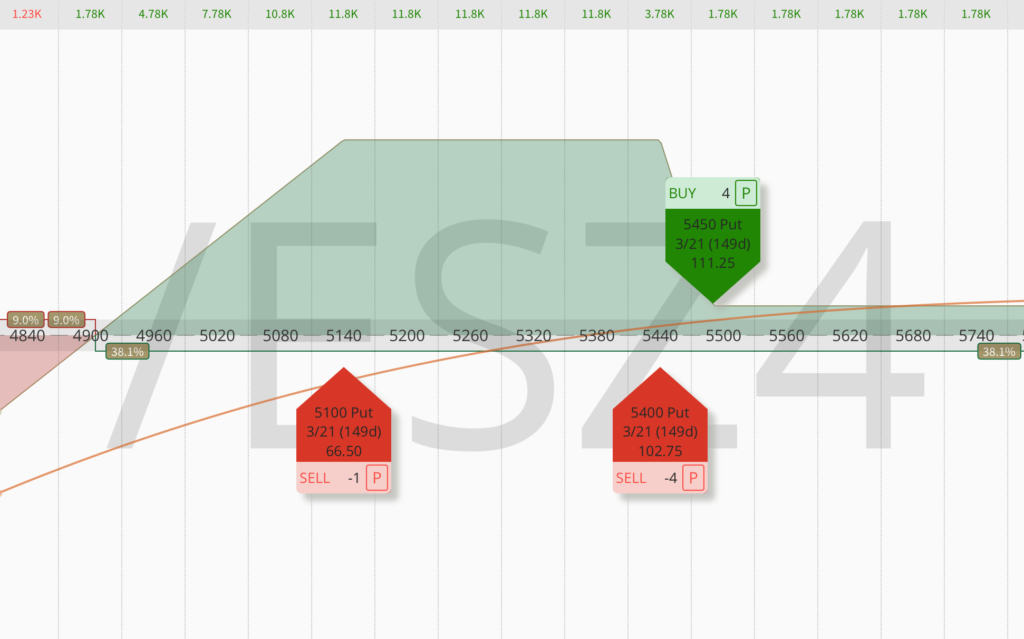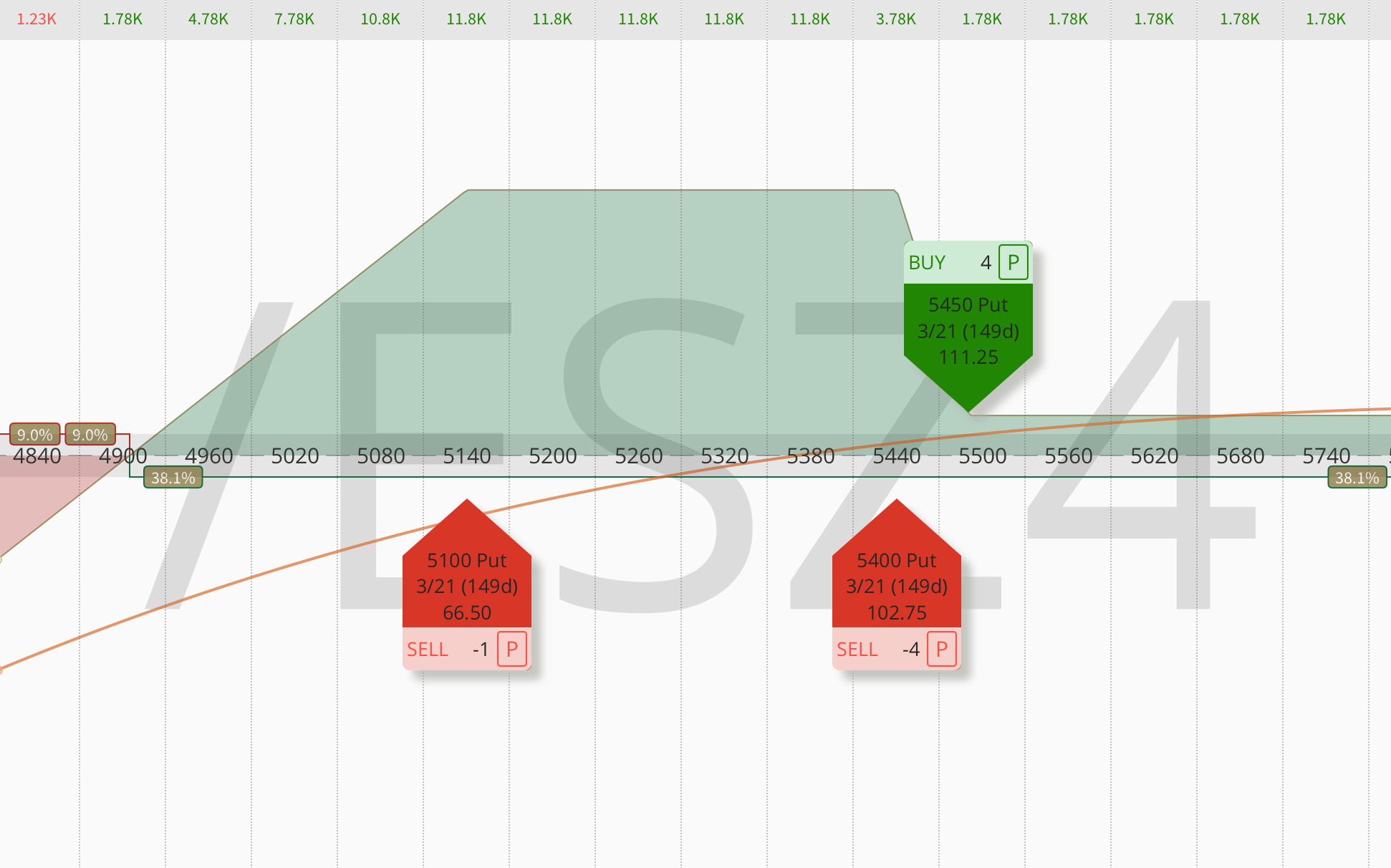The 1-1-2 options trading strategy presented in my previous article has been gaining popularity among traders, especially in several online communities. But before jumping on the bandwagon, it’s important to understand that this trade may not suit every trader, especially during volatile market conditions. In this post, we’ll explore the origins of the strategy, how it evolved from the 4-4-1 trade, and why it may not always be the best choice. I’ll also offer alternatives and variations that could better better suit your risk tolerance and market outlook.
The 4-4-1 Trade: Where It All Began
The 4-4-1 trade originated from a problem many traders face: consistently losing money on long put verticals, especially when the market moves against them. Tony Rihan developed this strategy as a way to address a common challenge faced by options traders: the risk associated with buying long puts and put verticals. One of the most frustrating aspects of these trades is that they often result in losses during bullish market moves, which occur more frequently than we’d like. The 4-4-1 was designed to allow Tony to buy a long put vertical with little or no cost, creating a more balanced risk profile.
Mechanics of the 4-4-1 Trade
Here’s a breakdown of the 4-4-1 strategy:
- Buy four long put options at the 25 delta. Tony emphasizes the importance of the 25 delta as a fundamental starting point for his strategies.
- Sell four short put options 50 points below the long put strike. This creates four long put vertical spreads.
- Sell one additional naked put further out of the money. The premium collected from this short option offsets the cost of the long put verticals, essentially financing the trade.
The key advantage of this setup is that it generates a large profit zone if the market moves lower. The four long put verticals provide significant upside potential, while the single naked put helps finance the trade and creates a buffer zone where the trade remains profitable even if the market declines moderately.

The Evolution from 4-4-1 to 1-1-2
The evolution from the 4-4-1 trade to the 1-1-2 trade involves progressively reducing the number of long put verticals while adjusting the position of the short naked put(s). This results in variations such as the 3-3-1, 2-2-1, or 1-1-1. As the number of long put verticals decreases, the maximum profit potential also shrinks. However, this is offset by the ability to move the short naked put further out of the money, increasing the break-even point and providing a larger buffer zone before the trade starts incurring losses. This trade-off between profit potential and safety is a crucial consideration for traders when choosing among these variations.
The 1-1-2: A Double-Edged Sword
The 1-1-2 trade represents the final stage in this evolution, consisting of one long put vertical and two short naked puts. On the surface, this setup seems safer, offering an even wider buffer zone if the market moves lower. However, there’s a hidden danger here. The main concern with the 1-1-2 trade is the increased risk associated with having two naked puts.
If the market crashes and volatility spikes, as seen most recently on August 5th, 2024, the two short naked puts can accumulate losses quickly, potentially leading to margin calls. Managing these naked puts in such an environment can create a significant financial strain, especially for traders without adequate capital. While some may argue that a Black Swan Hedge strategy could mitigate this risk, executing an effective hedge is complex and requires a high level of expertise – something not all traders can easily manage.
Final Thoughts and Considerations
The 1-1-2 trade might appear attractive due to its potential buffer zone and relatively simple mechanics, but it carries more risk than its predecessors, primarily because of those two short naked puts. Before considering this or any variation, it’s crucial to evaluate your own risk tolerance and market outlook. While the 4-4-1 and its variations offer a range of risk-reward profiles, the 1-1-2’s higher risk demands careful attention, especially in volatile conditions.
If you choose the 1-1-2 trade, be prepared for potential margin calls and ensure you have sufficient capital to handle market volatility. Ultimately, trading is an art that requires careful consideration and adaptation. By understanding the nuances of these strategies and their potential risks and rewards, you can make more informed decisions and navigate the options market with greater confidence.

One response to “The 1-1-2 Trade: Is It Really Worth the Risk? Discover Safer Alternatives”
Thanks for sharing valuable information. I ran the 112 campaign for a while and never lost a single trade. However, one night, while chatting with a friend, he asked me if I realized how much my notional was. After doing some math, I discovered I was 15x leveraged with futures options! I stopped the campaign and let the remaining trades hit profit. Now I’m completely out, and boy, was I happy I did it. On the night of the attack on Iran, I had only one position left, and the contracts exploded, causing my portfolio to drop by 1%. I waited until the morning, and it stabilized. Imagine if I had been in a full campaign, that would have resulted in a 15% drawdown in a matter of 5 minutes, just because of volatility. The market didn’t even move that much.